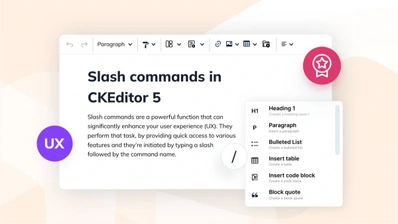5 best knowledge management tools for 2024

From customer preferences to business processes, both knowledge and experience play a key role in any organization’s intellectual capital. But the only way to ensure your business benefits from that knowledge, is to make it quick to share and easy to find. That’s where knowledge management (KM) tools come in.
Whether it’s a series of notes on a corkboard, or a group of Slack channels, all companies rely on a system for communicating and disseminating knowledge. Unlike a chat log or a handwritten note, a knowledge management system (KMS) is designed to help you store and share critical business information.
As more and more companies have realized the value of KM, the number of knowledge management tools has increased. Unsure which knowledge management system is right for you? Read on for a comparison of the best KM tools on the market.
Why is knowledge management important?
All businesses are only as effective as their team. Part of managing and training a team is ensuring that key knowledge and experience is shared and understood by all. But good knowledge management is about more than just collecting and reading information.
KM became a distinct management discipline in the 1990s, and as academic interest in the field grew, so did interest in the different types of knowledge that an organization relies on. Organizational theorist Ikujiro Nonaka outlines two contrasting types of knowledge:
Explicit knowledge, which is quantifiable and generally available to anyone within an organization, like a company’s annual financial report. Most companies consider this kind of hard data to be the most important type of knowledge.
Tacit knowledge, which is the subjective insights, experience, and intuitions of individual team members. This kind of knowledge is typically unquantifiable and often goes undocumented, but can be crucial to the overall success of a company.
The best knowledge management tools make it easy to store and share these different kinds of information.
What is a knowledge management tool?
A knowledge management tool (also known as a knowledge management system) is any piece of software to help organizations collect, store, and share information that’s important to the running of their business.
Depending on the size and complexity of the business, knowledge management tools can be as simple as a shared notes app, or as complex as an internal corporate database. Many companies rely on easily editable wiki pages, or document management tools like SharePoint to keep track of institutional knowledge. Even some content management systems can be used as knowledge management tools.
When looking for the best knowledge management solution for your company, it’s important to consider your office workflow. What kind of information do colleagues typically need? And how is it organized – in a single company-wide source or scattered over several apps? Perhaps most important of all: how straightforward is it for people to add information to your chosen knowledge management tool? If recording new data isn’t quick and easy, your knowledge base will quickly become outdated.
Here’s a review of some of the best knowledge management tools available – analyzing their key features, benefits, and drawbacks.
5 best knowledge management tools of 2024
With so many KM tools launching, there’s never an ‘ultimate’ list available. So here are five of the most popular knowledge management systems currently on the market.
1. Confluence
This wiki-inspired KM tool is made by Atlassian, owners of popular software development apps like Jira and Bitbucket. Confluence aims to be a platform for collaboratively creating and hosting a company knowledge base. Users can quickly create responsive web pages via a WYSIWYG editor and add tables, media, embedded documents, and more.
Content on each page can be dynamic, and there’s a search feature to help you find the information you need. To make adding pages simpler, there are predesigned templates for common page types and slash commands for quick actions. Confluence also offers simple collaboration features such as comments, mentions, and the ability to see a page’s revision history.
Confluence is available for free for up to 10 users, but all other plans are charged based on the number of Confluence users, meaning that costs can jump quickly as your business grows. And while Confluence has a number of integrations with other tools, many of the best integrations are with other Atlassian software, which limits its flexibility.
2. Helpjuice
Helpjuice is a cross between a traditional KM tool and a customer support portal. It allows companies to quickly create a knowledge base for their website or web app – thus enabling better customer support. Of course, Helpjuice knowledge bases can also be used for internal knowledge management, too.
To get you started, Helpjuice has a powerful WYSIWYG editor with a large range of styling and formatting features, from basic text alignment and block quotes to more complex content blocks and tables. You can even drag and drop files into the editor, and convert MS Word documents and PDF files into Helpjuice pages.
However, all those features mean there are a lot of options for people to deal with whenever they want to make or edit a page. The key to implementing an effective knowledge management tool is making sure you can customize it to your team’s needs. That means keeping only the features you’re actually going to use. So if you don’t require mathematical equation formatting or custom widgets, then those things shouldn’t be in your chosen solution.
3. Notion
Notion is one of the most popular productivity apps around at the moment. Unlike many of the other options in this list, Notion isn’t a pure knowledge management tool. Instead, it combines elements of a wiki, notes app, project tracker, and database. This means you can use Notion to make a company intranet portal, a document management system, kanban boards, a knowledge base, and more.
Notion’s editing interface uses the concept of content blocks. Each item placed on the page, from paragraph text to embedded tables, is a single block element that can be moved using drag and drop. You can even make interactive elements like clickable buttons and calculators. Notion is built for collaboration, so you can mention colleagues in pages, leave comments, and check a page’s revision history.
Unfortunately, the flexibility of Notion comes at the cost of a steep learning curve. Notion’s impressive array of capabilities can be overwhelming for new users, especially if they’re not looking to solve a complex use case. Notion offers AI integration to help speed up the creation of new pages, but its results can be mixed. If you’re looking for a straightforward KM tool, consider whether you need all Notion’s features.
4. OpenKM
One of the few open source knowledge management tools out there, OpenKM offers a flexible approach to knowledge management. You can use the software to make notes, store documents, and archive company mail. OpenKM even allows you to create an internal company forum.
Companies can choose to deploy OpenKM on-premise, or use a cloud-hosted deployment. The software’s modular architecture means teams can add features via plugins or even write their own custom plugins. To aid compliance, revision history is available, along with track changes.
However, using the free open source version of OpenKM comes with added technical challenges that your team would need to manage. Professional support is only available on paid plans. While OpenKM has mobile apps, they’re not as fully featured as the desktop software, which poses a challenge for colleagues on the go.
5. StackOverflow for Teams
This system takes a different approach from the other options on our list of best knowledge management tools. Made by the company behind the extremely popular developer forum, StackOverflow for Teams brings the same question-and-answer format to your organization. Rather than create a big knowledge base made up of lengthy articles filled with explicit knowledge, StackOverflow for Teams encourages the sharing of implicit knowledge. The system makes it easy for team members to quickly ask and answer questions asynchronously in a central place.
Just like on public StackOverflow questions, colleagues can use a WYSIWYG editor to style their text, embed media and code snippets, and even use Markdown for formatting. StackOverflow for Teams integrates with popular productivity platforms including Slack and Jira, so you can ask questions and search for answers from inside those apps.
While the Q&A format can make tasks like onboarding and tech support much easier, the major selling point of StackOverflow for Teams is also its main drawback. Any knowledge that doesn’t fit neatly into an ask-and-answer interaction can’t be captured by the system. And as with any forum, the quality of the information being shared depends on a robust moderation system, which colleagues may not have time to implement.
Building your own knowledge management tool
Despite the number of options on the market, many companies still struggle to find the best knowledge management tool for them. If your organization has specific requirements, edge case complications, or just doesn’t want to pay for a system with unnecessary features, it’s worth considering building your own KM tool.
The concept might seem daunting at first, but building your own knowledge management system doesn’t have to mean starting from scratch.
Any knowledge base is only as good as the quality of its data. That means the method for making and editing pages in your knowledge base must be both easy to use and able to handle a wide variety of content. All the apps listed above use rich text editors for input – they’re one of the most important components of any knowledge management tool. The standout features of every KMS in the above list rely on a WYSIWYG editor for implementation.
So choosing the right rich text editor can make or break your KM tool.
Supercharge your knowledge sharing with CKEditor
CKEditor is a flexible, enterprise-ready rich text editor purpose-built for collaboration. Its modular architecture supports a wide range of features, delivered via plugins. So you can customize the editor to ensure it perfectly suits your needs – with no unnecessary features.
CKEditor’s 300+ feature set includes a range of functionality for knowledge management:
-
Comments (Premium)
-
Track Changes (Premium)
-
Revision History (Premium)
-
Templates (Premium)
-
Slash Commands (Premium)
-
Import from Word (Premium)
-
AI Assistant (Premium)
-
Real-time and Asynchronous Collaboration (Premium)
You can deploy CKEditor on-premise or opt for cloud-hosted deployment instead. CKEditor is ideal for modern tech stacks, and has native integrations with the most commonly used front-end frameworks.
A CKEditor Commercial License allows you to integrate CKEditor with your knowledge management tool and select from our full range of Premium features. Productivity features, such as Templates and Slash Commands, are included in our Essential and Professional subscription plans.
To start improving knowledge management in your organization, contact us today.
This post was originally published on


